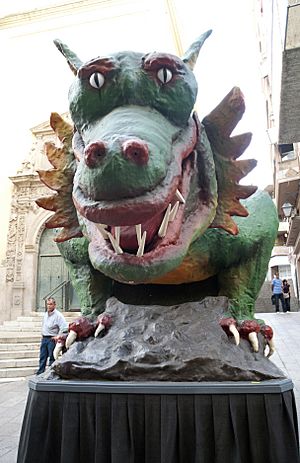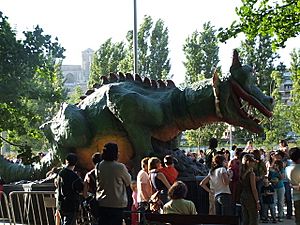Marraco facts for kids
The Marraco (called Lo Marraco in Catalan) is a legendary creature from the city of Lleida, Catalonia, Spain. It is often described as a dragon or a scary monster. Old stories say it had a huge mouth that could swallow a whole person! These tales were often told to children to make them behave.
Contents
What's in a Name?
The name Marraco might come from the Basque language word for 'dragon'. However, this idea doesn't have strong proof from language experts.
The Catalan word marraco can also mean a type of shark. In fact, the Basque word marraxo (meaning 'shark') seems to have come from the Spanish word marrajo.
Interestingly, the word marraco in Catalan also used to mean a 'large bull'. In some parts of Catalonia, like Mallorca, marraco could even mean 'shy' or 'wild', perhaps because wild boars are shy. While these words are related, they don't directly explain the name of the Marraco monster.
History of the Marraco
Ancient Legends
Some people believe that dragon-like creatures have been important symbols in the Lleida region since as far back as the 5th century BC. There's a claim that the ancient Ilergetes people, who lived there, thought their leaders were related to the Marraco, which they saw as a dragon god.
One description says this ancient Marraco was a "wingless green monster with sharp fangs and a twisted snout, spitting fire." However, other experts say that the Marraco we know today really got its look and color when a special prop was built for parades in 1907. This green dragon prop on wheels could blow smoke from its nose, but it couldn't breathe fire.
Medieval Parades
Since the Middle Ages, cities across Catalonia have held parades with giant figures called gegants. These figures look like giants, dwarfs, or even monsters. They are part of the Feast of Corpus Christi celebrations.
Other famous monster figures in Catalan parades include the Tarasca or Mulassa (from Barcelona and Tarragona) and the Cucafera of Tortosa. The Drac (dragon) of Vilafranca del Penedès is another example, similar to the Marraco of Lleida.
Records show that a dragon figure was used in Lleida's parades as early as 1551 for the Assumption of Mary feast. Another dragon was ordered to be built in 1671 for processions. These early dragons are seen as ancestors of the modern Marraco.
In Lleida's local stories, the Marraco was used by adults to scare misbehaving children into being good. It was said to have a huge mouth that could swallow children whole.
The Modern Marraco
The first official "Lo Marraco de Lleida" parade figure was made in 1907. Since then, different versions of it have appeared in major festivals. Besides Corpus Christi, the Marraco often comes out for the feast day of Saint Anastasi de Lleida on May 11. It even appeared on Saint George's Day in 2020.
The first Marraco from 1907 was used regularly until 1912 and made a final appearance in 1915. It was built on wheels, like a cart. Its original plaster covering was damaged by a storm, so it was quickly replaced with paper before a big festival. This first Marraco was designed to pretend to gobble up children through its large mouth and then let them out from its tail!
After a break, a new Marraco was built in 1941. But this dragon, made of plaster and wire on a truck frame, was too heavy. It needed many men to push it, so it wasn't used much.
In 1957, the City Council of Lleida asked architect Lluís Domènech Torres to design a new Marraco. This version was motorized, meaning it could drive itself through the streets. Because it was motorized, it couldn't "gobble up" children anymore. The driver controlled it, and two other people rode on it to make its neck swing and its head and jaws move. Its eyes would flash, and a scary scream would come out of a loudspeaker. It also blew smoke from its nostrils. While it didn't spit fire like some other parade dragons, its huge size was very impressive.
The Marraco used today was rebuilt in 1993, based on the 1957 design. Its old body of plaster and wood was replaced with fiberglass. This dragon also moves on wheels like a vehicle. It is about 8.5 meters (28 feet) long, 2.9 meters (9.5 feet) wide, and 3.75 meters (12.3 feet) tall.
See also
 In Spanish: Marraco para niños
In Spanish: Marraco para niños



